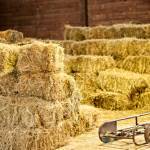Orchardgrass Hay for Horses

Glance through the “farm and livestock” section of most classified advertisements, and you’re bound to come upon listings for orchardgrass hay, and with those listings come sundry superlatives: “perfect for horses,” “ideal horse hay,” or “best hay for horses in the tristate area.”
Like any other preserved forage, the quality of orchardgrass hay marketed by farmers depends on multiple factors, primary of which are cultivation and harvesting techniques. When grown and cured under a watchful eye, orchardgrass hay deserves those superlatives. In fact, orchardgrass has been cultivated for pasture and hay since colonial times and has been an important forage in horse husbandry since then. Orchardgrass is commonly found thriving in shady areas, such as orchards and forest borders, which is where its name likely originated.
In addition to large areas of the U.S., orchardgrass is common throughout Europe, northern Asia, and the higher elevations of Africa. Additionally, it is found in some temperate regions of New Zealand and Australia.
Classified as a cool-season forage, orchardgrass is grown either in pure stands or with legumes, such as alfalfa (lucerne). Among grasses, orchardgrass does particularly well in mixed stands.
From a nutritional angle, as those classified advertisements indicate, orchardgrass can be a worthwhile component in almost any horse-feeding scenario.
“As a source of fiber, well-made orchardgrass hay has a place in the diets of all types of horses. When it’s clean and sweet-smelling, its palatability is wonderful, and few horses refuse it,” said Kathleen Crandell, Ph.D., nutritionist for Kentucky Equine Research (KER).
Because of its versatility, orchardgrass hay fits neatly into many feeding programs. With it as a foundation forage, it’s easy to build an appropriate ration, according to Crandell. “A fortified feed from a reputable company, fed at recommended levels, will complement orchardgrass hay incredibly well,” she said.
Easy keepers might be able to maintain moderate body condition on just the orchardgrass hay. Keep in mind that forage-only diets do not supply all of the nutrition horses require for optimal health. For mature horses, consider supplementing with a vitamin and mineral supplement such as Micro-Max or I.R. Pellet, both available in the U.S. For horse owners in Australia, choose Nutrequin, Gold Pellet, or Perform.
Despite its all-star reputation among horsemen, orchardgrass hay is susceptible to the same problems that befall all forage grown or harvested under poor conditions. Any orchardgrass hay that is dusty, moldy, or laced with weeds should be tossed.
Do you have a haymow chock-full of orchardgrass and not sure how to feed your pregnant mare, your weanling, or your show horse? Start a conversation with a KER nutrition advisor today.








